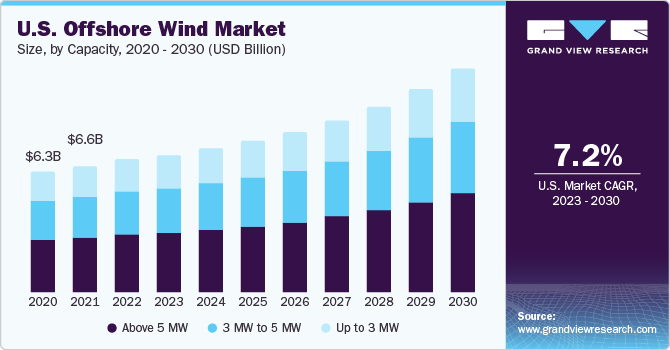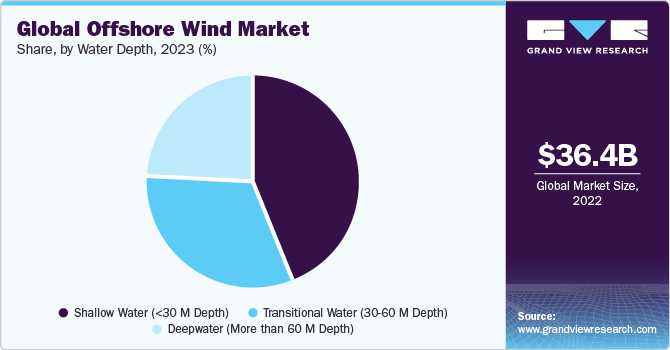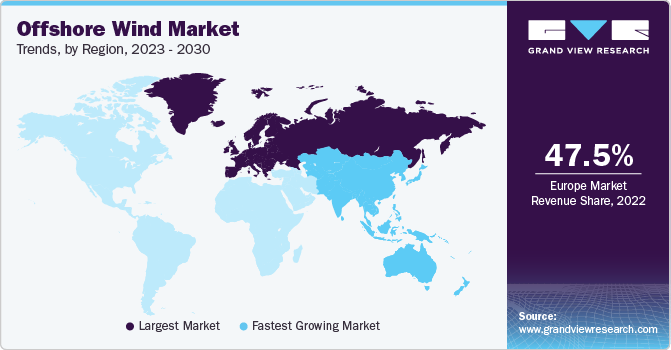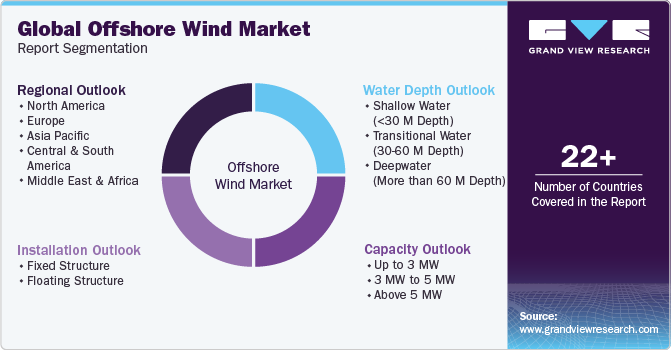- Home
- »
- Power Generation & Storage
- »
-
Offshore Wind Market Size, Share & Trends Report, 2030GVR Report cover
![Offshore Wind Market Size, Share & Trends Report]()
Offshore Wind Market Size, Share & Trends Analysis Report By Installation (Fixed Structure, Floating Structure), By Capacity (Up To 3 MW, Above 5 MW), By Water Depth, By Region, And Segment Forecasts, 2023 - 2030
- Report ID: GVR-4-68040-136-9
- Number of Report Pages: 110
- Format: PDF, Horizon Databook
- Historical Range: 2018 - 2021
- Forecast Period: 2023 - 2030
- Industry: Energy & Power
Offshore Wind Market Size & Trends
The global offshore wind market size was estimated at USD 36.39 billion in 2022 and is projected to grow at a compound annual growth rate (CAGR) of 7.97% from 2023 to 2030. The market is anticipated to expand due to growing interest in decreasing the global carbon footprint and increased demand for renewable energy sources. The growing efforts of government bodies and electrical companies to reduce carbon emissions are the primary market drivers boosting market expansion. Offshore wind is a substantial clean energy solution for large population centers seeking to get more of their power from clean sources, and lowering costs makes it more affordable.The U.S. is predicted to drive demand for offshore wind and is thus expected to propel the growth of the market in the coming years.

The U.S. market is predicted to experience significant growth in recent years, with several factors driving this expansion. The rise in expansion of industries including wind power owing to the growing need for dependable, clean, affordable, and diverse electricity supply is expected to boost the market growth in the country. The President of the United States announced a bold plan to install 30 Giga-tons (GW) of offshore wind by 2030, which would provide sustainable energy to 10 million homes, along with supporting 77,000 jobs, and encourage private investment throughout the supply chain.
The increasing intervention of the U.S. Department of Energy’s Bioenergy Technologies and other organizations is projected to fuel the growth of the market in the U.S. over the forecast period. Moreover, the rise in continued research, development, demonstration, and deployment of technologies to eliminate impediments to the widespread installation of offshore winds in the country is likely to drive market growth in the forecast period.
Capacity Insights
The above 5 MW segment dominated the market in 2022 with the largest revenue share of over 48.0% in 2022 due to advanced capacity and low cost. Higher power rating turbines are in high demand to make offshore wind power generation more energy-efficient and economically sustainable. Large-scale offshore wind projects benefit from economies of scale, making them more cost-effective in terms of power generation per megawatt-hour (MWh).
The expansion of offshore wind projects with capacities ranging from 3 MW to 5 MW represents a key component of the market. Offshore wind projects ranging from 3 MW to 5 MW provide a good blend of scale and flexibility. They are adaptable to diverse wind conditions and water depths, making them useful for a wide range of applications. These factors are likely to boost the demand for the segment over the forecast period.
Installation Insights
The fixed structure segment dominated the market in 2022 with the largest revenue share of over 57.0% due to a variety of factors, including ease of operation and cost-effectiveness. The growing desire for sustainable energy sources is a crucial driver in industry expansion, and the fixed structure installation segment is likely to create significant revenue in the coming years.
Wind turbine technological advances are projected to assist the industry's growth over the forecast period. The market for offshore wind installation is expanding due to the growing need for clean energy, and the fixed structure installation segment is likely to play a key role in most nations globally in achieving the renewable target.
Water Depth Insights
The shallow water (<30 M Depth) segment dominated the market with the largest revenue share of over 44.0% in 2023.The presence of considerably less demanding weather and ease of maintenance makes it a suitable choice for the establishment of offshore wind farms.

Moreover, shallow water installations are less expensive than deep-water installations, making them a cost-effective choice for large population centers seeking to source more of their power from clean sources. The market is predicted to expand internationally with the investments in renewable energy increasing. This factor is expected to boost the shallow water installation market.
Regional Insights
Europe dominated the market with the largest revenue share of over 47.50% in 2022. The growing need for renewable energy is a crucial factor driving the industry's expansion. Many European governments have identified offshore wind as a critical driver of economic recovery and the green transition. The rise in offshore wind production, stimulus packages, and government support programs are expected to boost the market growth in the region.

Government policies and regulations that are consistent and strong have played a critical role in promoting offshore wind growth in Europe. These development drivers have helped accelerate the expansion of offshore wind-generating capacity in European waters. Member states of the European Union (EU) have set high renewable energy targets, with offshore wind playing a crucial role in reaching these ambitions. By 2030, the EU has set a binding objective of using at least 32% renewable energy in its final energy consumption.
Moreover, Asia Pacific is expected to grow at a significant CAGR over the forecast period. With an increasing focus on sustainable energy sources globally, offshore wind power has emerged as a lucrative alternative for a variety of countries, including China, India, and Japan, driving regional market growth. Local governments are focusing more on developing seamless policies and regulations to make offshore wind energy a more viable alternative in comparison to other renewable energy sources. These factors are likely to promote the installation of offshore winds in the region.
Key Companies & Market Share Insights
The global market is highly competitive due to the presence of major industries across the region as these companies are comparatively concentrated and fiercely competitive along with acquisitions, mergers, and collaborations.For Instance, In February 2023, Siemens Gamesa announced its plan to develop a substantial offshore nacelle manufacturing facility in New York state. The facility will be built at the Port of Coeymans. It would represent a $500 million investment in the community and generate over 420 direct jobs. Some prominent players operating in the global offshore wind market include:
-
General Electric
-
Vestas
-
Shanghai Electric Wind Power Equipment Co.
-
Siemens Gamesa
-
Doosan Heavy Industries and Construction
-
Hitachi
-
Rockwell Automation
-
Nordex SE
-
Hyundai Motor Group
-
Schneider Electric
-
Zhejiang Windey Co.
-
Taiyuan Heavy Industry Co.
Offshore Wind Market Report Scope
Report Attribute
Details
Market size volume in 2023
USD 38.03 billion
Volume forecast in 2030
USD 65.04 billion
Growth rate
CAGR of 7.97% from 2023 to 2030
Base year for estimation
2022
Historical data
2018 - 2021
Forecast period
2023 - 2030
Quantitative units
Volume in MW, revenue in USD million/billion, and CAGR from 2023 to 2030
Report coverage
Volume & revenue forecast, company ranking, competitive landscape, growth factors, and trends
Segments covered
Installation, capacity, water-depth, region
Region scope
North America; Europe; Asia Pacific; Central & South America: Middle East & Africa
Country scope
U.S.; Canada; Mexico; Germany; UK; France; Italy; Spain; The Netherlands; China; India; Japan; South Korea; Australia; Malaysia; Singapore; Thailand; Vietnam; Brazil; Argentina; Saudi Arabia; UAE; South Africa
Key companies profiled
General Electric; Vestas; Shanghai Electric Wind Power Equipment Co.; Siemens Gamesa; Doosan Heavy Industries and Construction; Hitachi; Rockwell Automation; Nordex SE; Hyundai Motor Group; Schneider Electric; Zhejiang Windey Co.; Taiyuan Heavy Industry Co.
Customization scope
Free report customization (equivalent to up to 8 analyst’s working days) with purchase. Addition or alteration to country, regional, and segment scope.
Pricing and purchase options
Avail customized purchase options to meet your exact research needs. Explore purchase options
Global Offshore Wind Market Report Segmentation
This report forecasts revenue & volume growth at global, regional, and country levels and provides an analysis of the latest industry trends in each of the sub-segments from 2018 to 2030. Forthis study, Grand View Research has segmented the global offshore wind market report based on installation, capacity, water depth, and region:

-
Installation Outlook (Volume, MW; Revenue, USD Billion, 2018 - 2030)
-
Fixed Structure
-
Floating Structure
-
-
Capacity Outlook (Volume, MW; Revenue, USD Billion, 2018 - 2030)
-
Up to 3 MW
-
3 MW to 5 MW
-
Above 5 MW
-
-
Water Depth Outlook (Volume, MW; Revenue, USD Billion, 2018 - 2030)
-
Shallow Water (<30 M Depth)
-
Transitional Water (30-60 M Depth)
-
Deepwater (More than 60 M Depth)
-
-
Regional Outlook (Volume, MW; Revenue, USD Billion, 2018 - 2030)
-
North America
-
U.S.
-
Canada
-
Mexico
-
-
Europe
-
Germany
-
UK
-
France
-
Italy
-
Spain
-
The Netherlands
-
-
Asia Pacific
-
China
-
India
-
Japan
-
South Korea
-
Australia
-
Malaysia
-
Singapore
-
Thailand
-
Vietnam
-
-
Central & South America
-
Brazil
-
Argentina
-
-
Middle East and Africa
-
Saudi Arabia
-
UAE
-
South Africa
-
-
Frequently Asked Questions About This Report
b. The global offshore wind market size was estimated at USD 36.39 billion in 2022 and is expected to reach USD 38.03 billion in 2023.
b. The global offshore wind market is expected to grow at a compound annual growth rate of 7.97% from 2023 to 2030 to reach USD 65.04 billion by 2030.
b. The above 5 MW capacity segment dominated the offshore wind market with a share of 43.55% in 2022. Higher power rating turbines are in high demand in order to make offshore wind power generation more energy-efficient and economically sustainable.
b. Some of the key players operating in the offshore wind market include General Electric, Vestas, Shanghai Electric Wind Power Equipment Co., Siemens Gamesa, Doosan Heavy Industries and Construction, Hitachi, Rockwell Automation, Nordex SE, Hyundai Motor Group, Schneider Electric, Zhejiang Windey Co., Taiyuan Heavy Industry Co.
b. The market is expected to expand due to growing interest in decreasing the global carbon footprint and increased demand for renewable energy sources. The growing efforts of government bodies and electrical companies to reduce carbon emissions are the primary market drivers boosting market expansion.
Share this report with your colleague or friend.
![gvr icn]()
NEED A CUSTOM REPORT?
We can customize every report - free of charge - including purchasing stand-alone sections or country-level reports, as well as offer affordable discounts for start-ups & universities. Contact us now
![Certified Icon]()
We are GDPR and CCPA compliant! Your transaction & personal information is safe and secure. For more details, please read our privacy policy.
We are committed towards customer satisfaction, and quality service.
"The quality of research they have done for us has been excellent."





